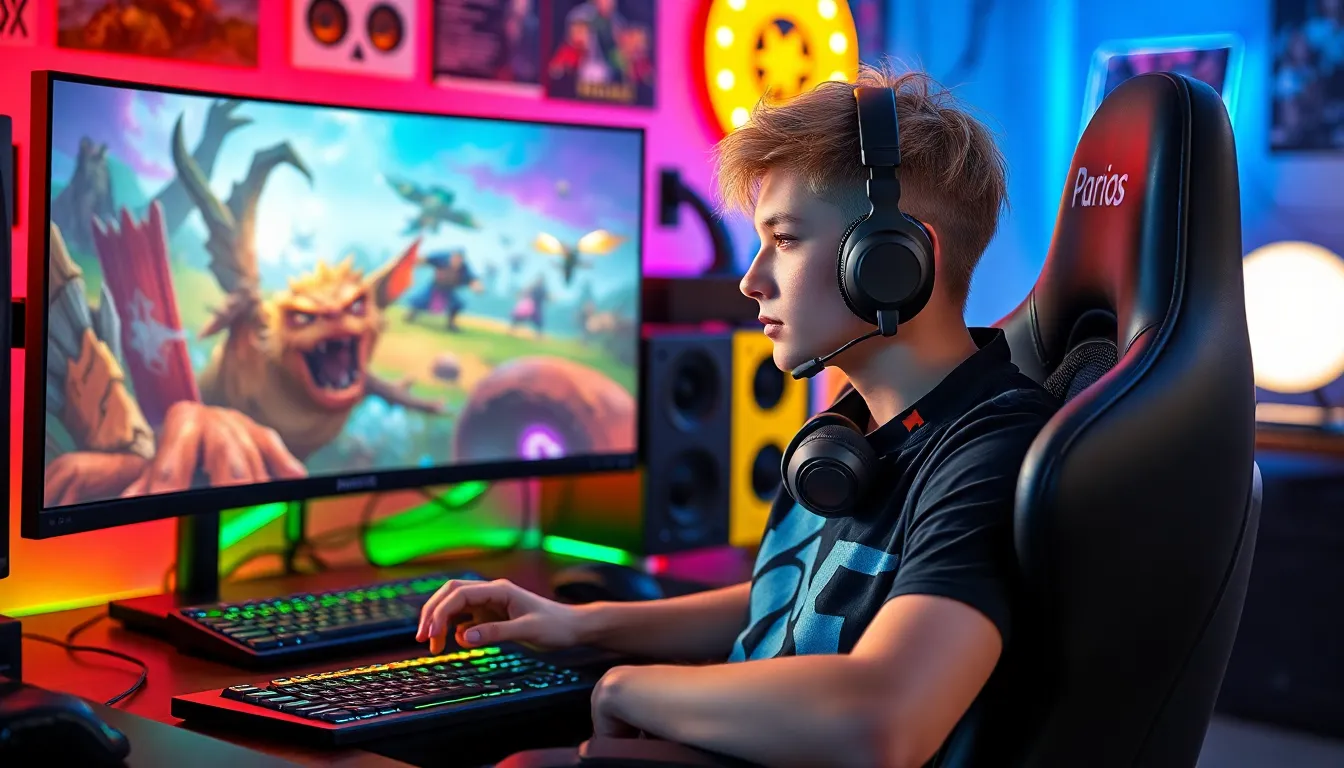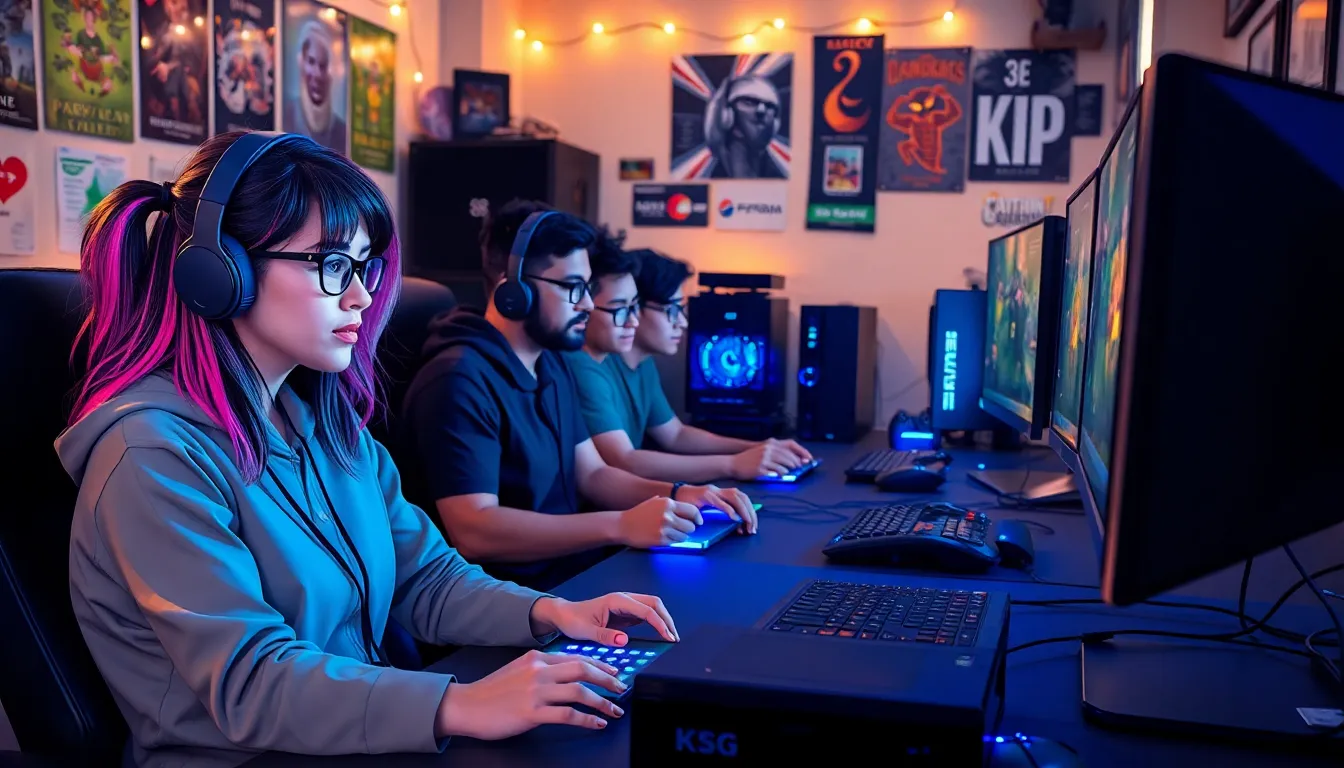
Gamer Subculture: How It’s Evolving and Connecting Communities in a Digital World
In a world where social interactions often happen through glowing screens and headsets, gamer subculture has emerged as a vibrant tapestry of creativity, camaraderie, and, let’s face it, a fair amount of snacks. From epic raids to meme-filled Discord chats, this community isn’t just about leveling up in games; it’s about forging connections that transcend the digital realm.
Gamer Subculture
Gamer subculture thrives within a digital landscape filled with technology. This community encompasses various gaming genres, platforms, and interests. Participants often engage through gaming events, online forums, and social media channels.
Identity plays a crucial role in defining this subculture. Gamers frequently express themselves via avatars, unique usernames, and in-game achievements. The sense of belonging fosters connections among individuals with shared passions.
Communities gather in platforms like Discord, Twitch, and Reddit to exchange ideas and experiences. Memes and shared jokes create an inclusive environment, often showcasing creativity. The social component extends beyond the screen, with many gamers forming lasting friendships in real life.
Esports adds another dimension to the subculture, where competitive gaming captures significant attention. Participants watch tournaments or compete themselves, showcasing skills and teamwork. These events often highlight the rise of professional gamers and the industry’s expanding economic impact.
Content creation also shapes the gamer lifestyle. Streamers and YouTubers share gameplay, providing entertainment and fostering conversations. Influencers significantly affect gaming trends, often dictating what becomes popular within the community.
Shared experiences in gaming, such as collaborative missions and intense challenges, strengthen relationships. Gamers often unite for charity streams, promoting goodwill while engaging their audience. This culture emphasizes mutual support and camaraderie in all aspects of gaming.
Clarity remains vital in the ongoing evolution of gamer subculture. Trends and interests continue to shift, influenced by technology, social changes, and new gaming content. Understanding this dynamic community requires attention to the nuances that define its rich tapestry.
Key Characteristics Of Gamer Subculture

Gamer subculture thrives on distinct characteristics that define its community and interests. These traits promote a unique identity and shape social connections.
Inclusive Community
An inclusive community characterizes gamer subculture. Gamers welcome individuals from various backgrounds, fostering friendships that extend beyond gaming. Diverse voices contribute to the richness of discussions on platforms like Discord and Reddit. A shared passion for games cultivates deep connections among members. Such interactions often lead to collaborative efforts, enhancing community bonds. They celebrate achievements together, whether through in-game successes or real-life milestones. Support during challenges creates a safe space for expression. Tolerance and encouragement dominate the environment, inviting everyone to participate without judgment.
Diverse Interests
Diverse interests further enrich gamer subculture. Different genres like RPGs, FPS, and puzzle games appeal to various gamers. Platforms range from consoles to PCs and mobile devices, catering to personal preferences. Gamers explore their interests through streaming, content creation, and community events. Esports events showcase competitive play, attracting audiences passionate about skill and strategy. Creative expressions surface through fan art, cosplay, and game modding, highlighting individual talents. Various gaming communities focus on specific interests, creating niche environments for enthusiasts. These interactions allow members to bond over shared passions, reinforcing a vibrant, multifaceted culture.
The Evolution Of Gamer Subculture
Gamer subculture has undergone significant changes since its inception. It reflects shifts in technology, community interaction, and player engagement.
Early Days Of Gaming
Gaming began in the 1970s with arcade machines and home consoles. Communities formed around local arcades, where players gathered to compete and share tips. Classic games like “Pong” and “Space Invaders” laid the groundwork for social interaction. Gamers connected through magazine forums, exchanging strategies and experiences. This early camaraderie sparked a unique sense of belonging among enthusiasts. Over time, consoles like Atari and NES expanded accessibility, drawing wider audiences into the fold. Social dynamics were primarily face-to-face, establishing the groundwork for future community building.
The Rise Of Online Gaming
The 1990s marked a pivotal shift with the advent of the internet. Multiplayer formats enabled gamers to connect globally through titles like “Doom” and “Quake.” Communities flourished on platforms such as IRC and early forums, fostering collaboration. Gamers discovered new ways to share experiences and strategies while simultaneously forming friendships. As online gaming expanded, so did the diversity of genres and player types. MMOs, such as “World of Warcraft,” brought players together in virtual worlds, enhancing social interaction. Online tournaments gained popularity, presenting new opportunities for competitive gaming. This evolution solidified the foundation for a thriving, interconnected gaming community.
Influences On Gamer Subculture
Gamer subculture draws influences from various aspects of society, especially media and technology. These factors shape identity, community interactions, and the overall gaming experience.
Media Representation
Media representation significantly impacts gamer subculture. Video games often reflect cultural narratives, creating characters and stories that resonate with players. Movies, television shows, and online content frequently depict gaming, helping to normalize and broaden the understanding of gamers. Characters in these media engage with audiences, making gamers feel acknowledged. Positive depictions foster inclusivity, while negative stereotypes can marginalize individuals. Major gaming conventions, such as E3 and PAX, also serve as media platforms, influencing trends and igniting discussions among fans.
Technology Advancements
Technology advancements transform the gamer experience. High-speed internet connectivity allows for seamless online multiplayer experiences. Improved graphics and innovative gameplay mechanics enhance immersion in virtual worlds. Game streaming services let players access a large library of titles without the need for expensive hardware. Virtual reality and augmented reality bring new dimensions to gaming, enabling unique interactions. Social media platforms facilitate sharing of gameplay moments, fostering community engagement. As technology evolves, gamer subculture adapts, continuously redefining what it means to play and connect in the digital realm.
The Future Of Gamer Subculture
Gamer subculture is poised for significant growth as technology evolves. Virtual reality and augmented reality are emerging trends that will impact how players interact and engage with games. Players can expect to see more immersive experiences that blend the digital and physical worlds.
Platforms like Discord and Twitch will continue to thrive, promoting real-time collaboration and communication among gamers. These communities are becoming increasingly vital in shaping gaming culture. Social connections built through shared interests will strengthen, fostering deeper relationships.
Esports will likely dominate as competitive gaming draws larger audiences. Tournaments are becoming mainstream events with massive prize pools, attracting international talent. With a surge in viewership, expected investment from major brands will elevate the status of esports.
Content creation will remain influential in shaping gamer identity. Streamers, YouTubers, and content creators contribute to trends by sharing unique perspectives. Gamers will see an enhancement in their roles as influencers within the community, driving discussions around various topics.
Inclusivity will become a cornerstone of gamer subculture. As more individuals from diverse backgrounds engage with gaming, unique narratives will emerge. Embracing different identities will enrich the gaming landscape, allowing for broader representation.
Technological advancements in game design will continue to reshape narratives and gameplay mechanics. Players will experience more nuanced character development and storytelling. Game developers will focus on creating worlds that resonate with a wider audience, fostering connections through relatable content.
The future of gamer subculture hinges on technology, community, and inclusivity, forging pathways for enriched experiences and lasting connections among players.
Conclusion
Gamer subculture continues to thrive as a dynamic and inclusive community. It fosters connections that extend beyond gaming, embracing creativity and collaboration. As technology evolves, so does the landscape of gaming, paving the way for richer experiences and deeper relationships among players.
The future promises exciting developments in virtual and augmented reality, enhancing engagement and immersion. Platforms like Discord and Twitch will remain essential for fostering community ties. With a focus on inclusivity and diverse narratives, the gamer subculture is set to redefine the meaning of connection in the digital age.
